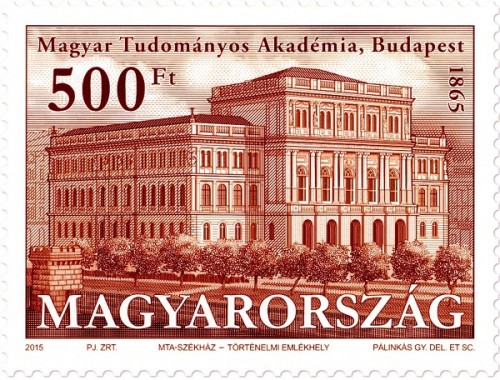
1. MAGYAR - 150 éves a Magyar Tudományos Akadémia székháza - Bélyeg vásárlás >>
2. ENGLISH - The headquarters of the Hungarian Academy of Sciences is 150 years old - Order stamp >>
1. MAGYAR - 150 éves a Magyar Tudományos Akadémia székháza
A Magyar Posta Zrt. alkalmi bélyeg kiadásával köszönti a Magyar Tudományos Akadémia székház építésének 150. évfordulóját. Az 500 Ft névértékű bélyeget Pálinkás György grafikusművész tervezte és metszette. A Pénzjegynyomdában készült 155.000 példányban. A bélyegképen a Magyar Tudományos Akadémia székháza található. Az alkalmi boríték előoldalán Holló Barnabás: A Magyar Tudományos Akadémia alapítása c. domborműve látható. Az újdonság november 10-től vásárolható meg a készlet függvényében az elsőnapi postákon valamint a Filapostán, de megrendelhető a Magyar Posta internetes áruházából is.
A Magyar Tudományos Akadémia 1865-ben átadott palotája Budapest várostörténetének és építészettörténeti fejlődésének egyik fordulópontján született, a historizáló neoreneszánsz egyik első, mégis legérettebb és legértékesebb példájaként. 1860-ban országos gyűjtés indult az épület megépítésére. A tervpályázatot 1861-ben írták ki és a győztes, neoreneszánsz tervet Friedrich August Stüler német építész készítette. A kivitelezés 1862 tavaszán kezdődött Ybl Miklós és Szkalnitzky Antal vezetésével. A felavatásra 1865. december 11-én került sor. Emil Wolff a homlokzati szobrokat, Holló Barnabás az alapítást ábrázoló domborművet készítette. A díszítésben mind a homlokzaton, mind a belsőben jelentős szerepet kap a korszakra oly jellemző allegorizáló törekvés. Ez nemcsak az építkezés időszakában, az 1860-as években jelentkezett, hanem akkor is, amikor a belső díszítés 20-30 évvel később megvalósított nagy befejező műve, a díszterem figurális és díszítő kialakítása elkészült. A díszterem freskói Lotz Károly nevéhez fűződnek, az üléstermet Ligeti Antal tájképei ékesítik. A Nemzeti Örökség Intézete a Magyar Tudományos Akadémiát 2012. január 1-jével történelmi emlékhellyé nyilvánította. Forrás: mta.hu
Legutóbb 1998-ban jelent meg Magyarországon metszet-mélynyomású bélyeg. Ennek a technológiának köszönhetően a nyomdafesték szinte plasztikusan, a papír síkjából kiemelkedve, a legapróbb részletek ábrázolását is lehetővé téve jelenik meg. Semmilyen más nyomdatechnika nem alkalmas arra, hogy ugyanazzal a festékkel ennyire gazdag árnyalati terjedelmet hozzon létre, pusztán a vonalak mélységének váltakozásával. Nem véletlen, hogy a magyar bélyegkiadásban a réz- és acélmetszésű bélyegek a teljes magyar bélyegpaletta részeként képviseltetik magukat. A jelenlegi kiadás technikai megvalósításának újdonsága, a közvetlen lézergravírozás (ún. direct laser engraving, DLE) technológia, ami lehetővé teszi, hogy a korábbi hagyományos formakészítés helyett, közvetlenül a többképes nyomólemezbe égesse a lézer a bélyeggrafika vonalait, jelentősen lerövidítve ezzel a gyártás időigényét. Forrás: Pénzjegynyomda
Forrás: Posta
Legyél te is az Bélyeggyűjtők csoport tagja >>
2. ENGLISH - The headquarters of the Hungarian Academy of Sciences is 150 years old
Magyar Posta is marking the 150th anniversary of building the headquarters of the Hungarian Academy of Sciences by issuing a commemorative stamp. The stamp has a face value of HUF 500, and was designed and engraved by the graphic artist György Pálinkás. One hundred and fifty-five thousand copies of the stamp have been produced by the printing company Pénzjegynyomda. The stamp design features the headquarters of the Hungarian Academy of Sciences. Barnabás Holló’s relief “The Foundation of the Hungarian Academy of Sciences” appears on the front of the first day cover.
The building of the Hungarian Academy of Sciences was inaugurated in 1865. It was built at a turning point in the urban and architectural history of Budapest and was one of the first yet most mature and valuable examples of the revival neo-Renaissance style. In 1860 a nationwide collection began to raise funds for the construction of the building. A design competition was announced in 1861 and the winning neo-Renaissance design was submitted by the Prussian king’s architect, Friedrich August Stüler. Emil Wolff made the façade statuary, and the relief depicting the Academy’s foundation is the work of Barnabás Holló. Allegorisation, a trend typical of the period, played an important part in the ornamentation of both the façade and the interior. This was evident both during the building’s construction in the 1860s and 20 to 30 years later when the masterpiece in the interior ornamentation, the figural and ornamental design of the ceremonial hall, was completed. The frescos in the hall were painted by Károly Lotz, while landscapes by Antal Ligeti adorn the Assembly Hall. On 1 January 2012 the Hungarian Academy of Sciences was declared a historic monument by the National Heritage Institute. Source: mta.hu
The last stamp issued in Hungary which was produced by intaglio printing was released in 1998. The technology imparts an almost sculptural quality to the ink, making it seemingly raised from the surface of the paper and showing even the finest details. No other printing technique can produce such a wide range of shades with the same ink by merely varying the depth of the lines. It is not by chance that copper and steel engraved stamps have their own place in the full spectrum of Hungarian stamp issues. The new feature of this issue is the technique used, direct laser engraving (DLE). DLE considerably shortens the time required for production compared to conventional plate making by burning the lines of the stamp design directly into the multi-image plate. Source: Pénzjegynyomda










